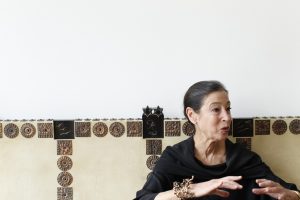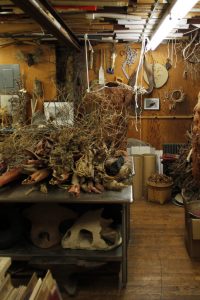Michele Oka Doner: Force of Nature
Sculpture, jewelry, public art, books and now, an upcoming retail installation — this contemporary renaissance woman does it all.
By Venessa Lau
Gesamtkunstwerk. A tricky knot of syllables, the word doesn’t exactly roll off the tongue. Still, artist Michele Oka Doner smoothly peppers the term — an old German word for an all-encompassing work of art — into a conversation about her new book, “What Is White,” a limited edition folio published by Dieu Donné earlier this year. In addition to the artwork featured, she crafted the book’s paper pages and even handwrote the text with a paintbrush.
Gesamtkunstwerk is actually an apt description of Oka Doner herself, who’s also a sculptor, author and jewelry designer. In 2011 alone, she completed the book; designed the label for Chiusa Della Vasca, an olive oil produced by her friend, former Artforum editor in chief Ida Panicelli; created an etched glass canopy for the Miami Intermodal Center; launched a line of wallpaper in collaboration with Studio Printworks; is participating in the current “Night Scented Stock” group show at New York’s Marianne Boesky Gallery (it ends Oct. 22), and, at December’s Miami Biennale, will host a paper works exhibit titled “Exhaling Gnosis.” But her pièce de résistance this year is still upcoming: a massive installation for Fifty One East, the luxury superstore in Doha, Qatar, set to be unveiled next month. “She’s a renaissance woman,” her friend Yeohlee Teng remarks.
Michele Oka Doner’s personal workshop.
Thomas Iannaccone
Need further proof? Oka Doner is the artist responsible for the sun-kissed brick walls in the underbelly of New York’s Herald Square subway station (1990), not to mention the marine-inspired granite and cast-bronze floors throughout Miami International Airport (1995-1999). As for the TV world, she once taught Martha Stewart how to make banana-leaf paper on the decorating doyenne’s show, and was a guest judge on the first season of Bravo’s “Work of Art.”
“People say sometimes, with surprise, ‘You use so many different materials, you make so many different things,’” says Oka Doner, a Miami Beach native who splits her time between there and New York. “Well, of course. Why wouldn’t you? Why do people feel they need to stake a claim in a small arena?”
For this interview, the artist, dressed in a custom-made draped black dress (more on that later) and black Prada slippers, is giving a tour of her cavernous SoHo loft — a former button factory which, by the way, was the real-life template for Patrick Swayze and Demi Moore’s apartment in “Ghost.” The 4,800-square-foot space is a rich panoply of textures and curios, and practically everything in it is of her own creation. She designed the closet doors and bar stools, the fireplace pokers, the colossal bronze table. Ditto the crystal fishbowls that sit on top of the latter (electric blue Siamese fighting fish swim inside), which were a 2007 collaboration with Steuben Glass. She did not, however, craft the curved Bugatti bench and chairs that rest near the entrance. They belonged to Andy Warhol.
It’s all a decidedly eclectic mix that reveals Oka Doner’s love for nature. Her jewelry and sculptures always take on organic textures and shapes — much of it inspired by driftwood, the ocean and her upbringing in Miami Beach. But not the Miami Beach of electro-lights and spring-break coeds. “It was a bit more unruly and feral when I was growing up,” says Oka Doner, whose father was the city mayor in the late Fifties and early Sixties. “I spent my formative years in the backyard, watching the stars and playing Tarzan in the trees.”
Surprisingly, her downtown home pulses with the same rough-hewn vibe. Almost every surface is neatly crammed with found-object oddities: dead cicadas, bulbous roots, nuts, twigs, shells and snippets of coral. “I coax them into performing for me,” remarks Oka Doner, stepping into a small, dark workshop in the back that’s chockablock with more specimens and the abundant art inspired by them. She notes that even in New York, she finds plenty of nature to pluck — she admits to picking up grape stems, flattened by trucks, off city sidewalks.
“She’s a truffle hog,” says Harold Koda, curator in charge of the Costume Institute at the Met, which holds two of Oka Doner’s works in its archives — a necklace she created in 1991 for Ronaldus Shamask (she also designed the jewelry for Shamask’s return to the runway in September) and a handbag from a 2006 collaboration with Nancy Gonzalez, its handle, a gnarled sterling silver branch. “She rummages through nature and comes up with all these treasures,” Koda adds.
Getting back to the big Doha project at hand, Oka Doner gestures to its architectural drawing — a huge cavelike piece at the far end of the main room. At first glance it looks like a mural but it’s actually a jumbo roll of paper that stretches up to the 18-foot-high ceiling. On it she’s painstakingly drawn a mosaiclike pattern, in tiny strokes, with a thick black marker. Doha has a history in pearl fishing, so her sketch is of mother-of-pearl seen through a microscope.
Made from steel and covered in gold leaf, the installation will be one giant concave canopy to hang in the middle of Fifty One East, suspended just above the second-floor escalators. In a nod to her inspiration, 1,500 baroque pearls will trim its edges.
While Oka Doner has clearly made her name in the public art sector — she’s also responsible for the entrance to the Hayden Planetarium at New York’s American Museum of Natural History, the soaring obelisks at Ocean Park Beach in Santa Monica, Calif., and a whole host of installations at libraries, courthouses and universities across the country — she’s now finding her comfort zone in retail; the Doha project marks her third store renovation. The first came in 2007 when she revamped the sales floor at Joyce in Hong Kong, convincing founder Joyce Ma, a friend and client, to go for a beehive motif. “I told her we needed to make the space alive, active and random,” Oka Doner says, describing the gilded filigree dome at the center of the designer ready-to-wear salon. “I liked the idea of activity and made a narrative. I said, ‘Joyce, you’re a queen bee.’”
She lent a hand when Saks Fifth Avenue unveiled its new designer floor in 2009, creating the bronze chandeliers that hang in the shape of weeping cherry trees, as well as the reeflike, gold-leaf scrims throughout. “I’ve known Michele for years and years,” says Terron Schaefer, executive vice president and chief creative officer of Saks. “The chandeliers were inspired by her Burning Bush sculptures. They’re unbelievably graceful and beautiful — people react.”
“In each case, I try to inject the space with a sense of life,” Oka Doner explains. “Think of those great domed shopping piazzas in Milan, where you feel removed from the ordinary world. I try to do that, whether it’s Miami International Airport or a store. There’s a momentary release from the real world into something with imagination and beauty.”
As poetic as Oka Doner can get, she’s also a serious fashion hound. Her closet is a vintage troller’s dream, full of early Oscar de la Renta, Jean Paul Gaultier and Yohji Yamamoto pieces. “If you buy something special every year and you’ve had about 45 adult years like me, you have a lot of very good dresses,” she says.
Yet Oka Doner prefers to wear a single style dress: a roomy long-sleeve number with a draped neckline that falls over the shoulders (she’s wearing just that today). She owns about three dozen — mostly in black and white, cut from cashmeres, silks and velvets. They’re all custom-made, save for the original which she bought in a store in Chelsea in 1987. “I recycle them,” she adds. “The white ones start looking not so white so I wear them to walk on the beach. And then in the end, I use them in the studio. I wrap my bronzes in them.”
Oka Doner says her style savvy — and the confidence that goes with it — owes much to her roots, especially her mother, Gertrude. As evidence, the artist pulls out the book “Miami Beach: Blueprint of an Eden” — a wonderful tome on the city which she co-wrote with Mitchell Wolfson Jr. in 2005. Her chic mom is on the cover (dressed in a palm-printed two-piece) and also in endless photos inside, from hosting local fashion shows to posing with Madame Chiang Kai-shek. As Oka Doner flips through the pages, a bronze and diamond cuff in the shape of a branch shines on her right hand — it’s her own design, of course. “Art and beauty should be everywhere,” she remarks. “Every surface should be thought about and curated.”
A sample of the natural miscellany at Michele Oka Doner’s home.
Thomas Iannaccone




